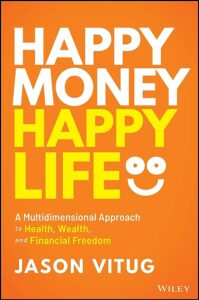Written By: Dr. Barbara O’Neill, CFP®, AFC®
 Happy Money, Happy Life was written by a New Jersey financial education colleague, Jason Vitug, whom I have known for years. Full disclosure: I was one of dozens of people interviewed by Jason for insights and quotes. The book is tightly organized into three sections (called Books) and its main theme- and unique contribution- is an in-depth discussion of connections between financial health and overall happiness and well-being.
Happy Money, Happy Life was written by a New Jersey financial education colleague, Jason Vitug, whom I have known for years. Full disclosure: I was one of dozens of people interviewed by Jason for insights and quotes. The book is tightly organized into three sections (called Books) and its main theme- and unique contribution- is an in-depth discussion of connections between financial health and overall happiness and well-being.
Happy Money, Happy Life begins with a discussion of money and happiness in Book I, followed by eight happiness dimensions (Happy… Money, Work, Mind, Heart, Body, Social, Space, and Spirit) in Book II, with a chapter devoted to each. Book III focuses on personal finance and discusses money beliefs, money vitals (i.e., financial health numbers), and nine paths to financial happiness (e.g., investing and repaying debt). Jason also includes personal experiences, struggles, and poems which illustrate key concepts and provide authenticity.
Below are some useful insights for financial practitioners:
Book I: In Pursuit of Happiness
- Happiness is Personal– It varies from person to person. Money, and- by extension- financial health, give people choices and choices can lead to happiness. People who feel autonomy and a sense of control over their lives report feeling happier than others, thereby making it smart to focus on things you can control.
- More Money, Less Stress– Money is a resiliency resource. Having more money supports less stress because it enables people to deal with various stressors (e.g., the COVID-19 pandemic). Money can also help people buy back time to spend on personal pursuits, like exercise and building social connections.
- Wellness Definition– Wellness is not the absence of illness. Rather, it is a process of making mindful decisions to live a balanced and meaningful life. Wellness in multiple life dimensions makes people happy long-term and reduces stress. Financial wellness provides time and money to improve other life dimensions.
- Money is a Resource– Money can help solve life problems (e.g., medical bills), address nuisance events (e.g., a flat tire) and buy happiness but only up to a point. Examples: it can buy time (e.g., early retirement) but not a purpose…or a house but not inner peace. Money also changes people’s lives through purchases.
Book II: Happy Life
- Happy Money- Financial wellness is happy money and the ability to meet current and future financial needs. Ways to achieve it include saving purposefully (e.g., for emergencies and purchases), developing multiple income streams, spending mindfully, investing intentionally, and giving graciously.
- Happy Work- This is where people balance work with leisure and do work that is both satisfying and financially rewarding. In other words, “you don’t sacrifice other parts of your life for professional achievements.” Skills, experiences, and networks from work experiences are all transferable.
- Happy Body- Excessive “hustle and grind” culture results in people sacrificing their mental and physical health for professional and financial gains. Some of their money will likely be spent on medical treatments. Being healthy supports wealth: fewer medical bills and a more likely long lifespan for investments to grow.
- Happy Social/Happy Space- Interpersonal connections are invaluable but must be cultivated and nurtured. Conversely, having money enables people to leave abusive relationships and avoid toxic people. Clearing one’s home/office of clutter also supports happiness and well-being (reduces feeling of “overwhelmingness”).
Book III: Choosing Financial Happiness
- Signs of Financial Wellness- Indicators include: not losing sleep over money, paying bills on time, avoiding overdrafts, using credit intentionally, contributing to retirement plans, paying yourself first (i.e., automatic savings), living within your means, and having a back-up plan for emergencies.
- Money Beliefs- Mindsets about money inform financial habits and behaviors, and drive decisions about saving/investing and spending (e.g., needs vs. wants). Building wealth fosters security and peace of mind, and is not a selfish act. Wealth is saved, not spent, and differs from “rich,” which is what people see.
- Money Vitals- Five key numerical metrics to measure financial health include net worth, cash flow, income number (number of sources of income and the total amount), credit score, and debt-to-income ratio. Like physical exam numbers, “money vitals” are important to assess where you are and chart a path forward.
- Happy Money Paths- The book describes nine independent- but complimentary- paths to financial happiness: save for the unexpected, prepare for retirement (e.g., employer savings plan and Roth IRA), pay off debt, earn more money (e.g., active, passive and portfolio income), start investing right now, be creditworthy, protect your assets (e.g., deter identity theft, buy insurance, prepare estate planning documents), set up an “ultimate safety net” cash reserve (12-24 months of living expenses), and calculate your financial independence (FI) number (desired annual expenses x 25) and number of years to FI.
Summary
I recommend Happy Money, Happy Life, especially for those doing financial education or counseling with an interdisciplinary “whole person” (life planning) lens. Written by a Millennial, it skews toward topics of interest to young adults. As someone older, I found many sections did not apply to me or were “been there, done that.” After reading Happy Money, Happy Life for a basic framework, books written for older adults, including mine (yes, shameless self-promo), can provide happiness/financial wellness content targeted for this demographic.
